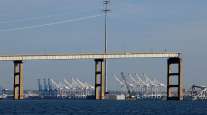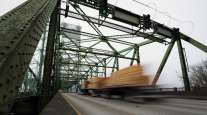Staff Reporter
$100 Million Maryland Grant to Fund I-81 Lane Expansion

[Stay on top of transportation news: Get TTNews in your inbox.]
Construction will move forward to ease congestion in western Maryland and improve regional freight transportation along Interstate 81 after Gov. Larry Hogan awarded the project a $100 million grant.
I-81 is the main freight connectivity corridor in Maryland that links New York to Tennessee.
“Our administration has been committed to making these transformative improvements to the I-81 corridor from day one because it is such a critical economic lifeline for the communities and businesses of western Maryland, and it is vital to our interstate supply chain,” Hogan said Jan. 3.
In Washington County, I-81 is the primary north-south interstate highway and is only four lanes wide but supports among the highest freight volumes in the U.S. by lane mile. According to Maryland Department of Transportation, I-81 in some areas carries more than 77,000 vehicles daily, of which 27% are trucks.
Hogan’s decision to allocate the money to pay for Phase 2 construction on I-81 came after the U.S. Department of Transportation did not award a grant under the new Rural Surface Transportation Grant Program, Hogan’s office noted.
“Following the federal decision, the governor directed Maryland Department of Transportation officials to develop alternatives to advance the project,” it added.
MDOT last year requested $65.04 million from DOT for the “I-81 Freight Capacity & Connections Project” to complete Phase 2 of a four-phase, 12.1-mile, multiyear project with an estimated cost of $400 million.

What is the outlook for trucking in 2023? How will the industry change with the current government, economic and business trends? Join host Michael Freeze and TT reporters Eugene Mulero and Connor Wolf. Hear the program above and at RoadSigns.TTNews.com.
In its May 23 grant application, MDOT stated, “I-81 is vital for the distribution of raw materials and finished goods between Appalachia and some of the largest consumer markets in the Northeast. Several major North American distribution facilities are located near the I-81 project segment, including Tractor Supply Co., Sealy Mattress, FedEx, Home Depot, Fives Landis, an Amazon fulfillment center and other warehousing and distribution centers.”
Essential products moved include gravel, sand, wooden items, nonmetal mineral products, plastics, animal feed, foodstuffs, pharmaceuticals, machinery, motorized vehicles and furniture. Freight trucked over I-81 is responsible for some 10% of the nation’s gross domestic product and has a gross value over $1.85 trillion.
Now state funds from the fiscal 2023-28 Consolidated Transportation Program will be spent on the I-81 project in Washington County to widen the interstate from four to six lanes to provide one additional lane in each direction along 4 miles between Maryland routes 63 and 68, and the CSX railway bridges north of Halfway Boulevard.
The first phase of the I-81 project has been completed to improve the roadway from West Virginia to Md. 63/68. The governor’s office noted that Maryland also has delivered related system preservation projects in the corridor and funded design/engineering for I-81 Phase 2.
Want more news? Listen to today's daily briefing above or go here for more info
“Improvements to I-81 are vital to prepare Maryland for the growth we know is coming to the logistics and supply chain network from good-paying jobs in Baltimore City at Maryland’s Port of Baltimore to jobs in western Maryland at growing logistics centers,” MDOT Secretary James Ports Jr. said. “This commitment from Gov. Hogan is an investment in the future and will pay dividends here in Maryland and across the region for generations to come.”
Part of the second phase involves building two new electric vehicle charging locations to support and encourage expansion of EV truck fleets by providing charging infrastructure convenient to both I-81 and I-70.
I-81 improvements are being made by MDOT to support an ongoing Howard Street Tunnel expansion project in Baltimore expected to bring double-stack capacity for container railcars and increase demand for trucks delivering freight across Maryland’s highway network.
Much of the state’s freight comes from the Port of Baltimore, a gateway for e-commerce goods and cargo heading to the Midwest by rail and throughout the Mid-Atlantic and neighboring states by truck.




